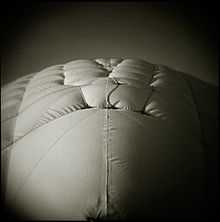Toy camera



Within the field of photography, a toy camera refers to a simple, inexpensive film camera.
Despite the name, they are in fact always fully functional and capable of taking photographs, albeit with optical aberrations due to the limitations of the simple lenses. From the 1990s onward there has been interest in the artistic use of such cameras, both those designed for children such as the Diana, others originally intended as mass-market consumer cameras such as the LOMO LC-A, Lubitel, and Holga.
Many professional photographers have used toy cameras and exploited the vignetting, blur, light leaks, and other distortions of their inexpensive lenses for artistic effect to take award-winning pictures.[1] Toy camera photography has been widely exhibited at many popular art shows, such as the annual "Krappy Kamera" show at the Soho Photo Gallery in the Tribeca neighborhood of New York City. Various publications such as Popular Photography magazine have extolled the virtues of the Diana camera in its own right as an "art" producing image maker. Several books have also featured the work of toy cameras, such as The Friends of Photography's "The Diana Show", "Iowa" by Nancy Rexroth, and "Angels at the Arno" by Eric Lindbloom.
Examples
- Diana, children's 120 film camera
- Holga, Chinese mass-market 120 film camera
- LOMO LC-A, mass-market Russian (originally, now made in China) 35mm camera
- Lubitel, mass-market Russian 120 film twin-lens reflex cameras
See also
References
- ↑ Schiesel, Seth (8 June 2005). "Which Camera Does This Pro Use? It Depends on the Shot". New York Times. Retrieved 4 May 2010.